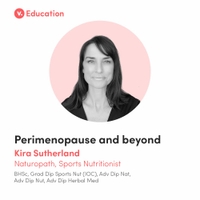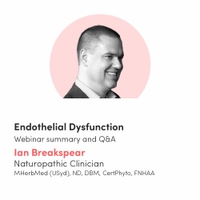Autoimmune disease update and assessing the research for treatment options
Autoimmune illness or disease occurs when the body’s tissues are attacked by its own immune system.
Over 4% of the world’s population suffers from one or more of over 80 autoimmune diseases identified to date.
Janet discussed five auto-immune diseases
- Rheumatoid arthritis (RA)
- Sjogren's syndrome
- Scleroderma
- Lupus
- Ankylosing spondylitis
For each disease, Janet discussed:
- Aetiology and epidemiology
- Differential diagnosis
- Conventional treatments
- Naturopathic treatment aims and options
- Dietary interventions
- Nutrient supplementation and their dosages
- Key herbal medicines and their dosages
- Complications from the diseases
- Case study.
Key Take Away Points
- Treat the individual at the stage of disease/condition they are currently undergoing
- Assess the gut microbiome and balance gut flora – probiotic therapy as required
- Address dietary requirements – Anti-inflammatory and Mediterranean diet
- Modulate the immune system – Vitamin D3, Astragalus, Hemidesmus, zinc
- Reduce inflammation – turmeric, Omega 3-fatty acids, Nigella sativa
- Don’t give drying herbs or nutrients such as N-acetyl-cysteine (NAC) to patients with Sjogren’s syndrome or scleroderma
- For people with scleroderma, try to reduce fibrosis by supplementing with bromelain or serrapeptase. Needs to be taken away from food, at least one hour
- Most people with systemic scleroderma need low fibre/FODMAP diet to assist motility
- People with Sjogren’s syndrome need ‘wet’ foods to assist with digestion and ease of eating
- Fasting followed by a vegetarian diet can modulate the gut microbiota, reduce inflammation, and assist with reducing disease activity.
Questions from Autoimmune Webinar
Q and A time during the live webinar covered many engaging aspects Janet discussed.
Here are some of the questions not covered during the live webinar.
Is Dyshidrotic eczema autoimmune disease in both children and adult?
No, this isn’t considered an autoimmune disease. I actually have this. It’s also called pompholyx dermatitis and is a high T helper 2 immune response rather than high T Helper 1. Stress and excess water or humidity can set it off.
Will there be a discussion of LDN (low dose naltrexone)?
No, I didn’t speak about LDN mainly because low dose naltrexone is prescribed by doctors and is not considered first line treatment. In saying that, it does work really well in a number of different auto-immune diseases and is well tolerated. It’s mostly used for fibromyalgia, Crohn’s disease, MS, cancer and certain other pain syndromes.
How are you testing the microbiota?
I use various tests, but mostly Microba comprehensive stool test.
Has anyone seen an issue with NAC causing gut issues?
NAC can cause gut issues in certain people and conditions. The main side effects from NAC are dry mouth, dry mucus membranes, nausea, vomiting and diarrhoea so it’s fairly well known that it can cause gut issues, it’s not spoken about by a lot of supplement companies.
There are also studies looking at methylation with SLE, and Sjogren’s, so do you look at specific nutritional support for affected pathways in your practice?
Yes, certain methylation pathways do play a part with SLE and Sjogren’s. It is something that I look into and take into consideration with all other aspects of the person and the case. I don’t however just focus on methylation alone as I believe it’s only one part of what’s going on.
Is there any other form of spondylitis that isn't autoimmune?
Yes, there are a number of spondylitis’s that are not autoimmune. There is a group called spondyloarthritis that isn’t an autoimmune disease that people can be diagnosed with which is mainly an inflammatory arthritis.
Would 60000IU have an effect on calcium? ( vitamin D)
Having high doses of vitamin D over a period of time can affect calcium. Normally you will calcium levels rise which can cause hypercalcemia.
Would you use echinacea or would you consider it a drying herb for those "dry"conditions?
I do consider echinacea a drying herb so it’s not one I normally use in those conditions like Sjogren’s or scleroderma.
Can you please touch on Complement C3 and C4?
Absolutely, the complement system is part of our immune system and made up of proteins that fight disease. C3 and C4 are two of these of which they are used to monitor our immunity. If these complement proteins are found to be not normal or out of range, it’s a sign of autoimmune disease such as Lupus or RA. There are 9 complement proteins but C3 and C4 are the most commonly tested. They can also be used for cirrhosis, kidney disease, malnutrition, and some bacterial and fungal infections. Most of the time, if the ANA comes back slightly raised or speckled, the doctor will then do further tests like C3 and C4 to see what is going on. They are also commonly tested to monitor disease status.
Why don't you use Hemidesmus in RA, and you use in Scleroderma?
Usually because RA patents are on numerous other medications, and I haven’t found it works as well. Doesn’t mean it can be used for RA and that it could work but I normally go more to the turmeric and nigella for RA.
Have you treated Morphea a type of scleroderma with success?
I treat it very similar to psoriasis.
Orally vitamin D3, nigella sativa, hemidesmus, probiotics, dietary changes.
Topically I would try a few things to see what works:
- In a vitamin E base I would put vitamin D, zinc and ginger or turmeric liquid - then rub in affected sections
- The other one I would try is topical cannabis.
Do you know a herbal remedy alternative preferably to steroids to manage lichen sclerosis? (vaginal)
You can try a few things in a coconut oil-based suppository. You can try putting in nigella sativa, turmeric, vitamin D3, made up into suppository to see if that helps.
If that doesn’t, I would look at CBD as a suppository to see if that helps.
I have seen this a few times especially in post-menopausal women, and it’s not nice.
What are the side effects of hydroxychloroquine and Imuran and the associated long-term damage? Is there a risk the body can become resistant to these drugs over time?
Actually, the highest risk of long-term use of hydroxychloroquine is cardiomyopathy and cardiac disease or attack which people do need to take into consideration. For Imuran it has a higher risk of development of cancers particularly lymphoma and leukemia plus skin cancers. There are many common side effects from the medication mostly gastrointestinal. In regard to becoming resistant, it’s not something they say you do become resistant to.
What are the benefits of jumping into a dramatic new food & supplement solution when dealing with youth/teens? What are your strategies or do you struggle with that group? Is vitiligo serious enough to treat in this way too or is it harmless.?
Teens and youths are very interesting group. Some because of their symptoms I have found to be very compliant and make the changes, particularly females. Males on the other hand aren’t always as compliant. I find negotiating with them to see what they are willing to do and can maintain the best strategy as its engaging them in their treatment plan.
Vitiligo is not serious enough to really make them make major changes I don’t think but it will depend on the negotiation.
Q. I have client with traumatic vitiligo with having family history in his maternal grandfather. One of the causes is due to cellular responses to stress, including antioxidant pathways and unfolded protein response (key players in disease onset (IL-6 and IL-8). Sunburn and chemicals are stressors. SOD has been linked to traumatic vitiligo.
My question is:
Q1-"how are the responses in use of SOD, broad band UVB, topical corticosteroid, topical calcineurin inhibitor, topical vitamin D analogue respectively" or any other natural supplement for treatment of traumatic vitiligo"?
I actually think it would be great to try a SOD and vitamin D cream topically on the areas affected to see if that is of assistance. I wouldn’t put it on the same time as corticosteroid creams etc. but I do think it’s worthwhile to try. I think each case is different and you have to try things to see if they are going to work or not on that person.
Q2-How is the traumatic vitiligo associated with other autoimmune diseases?
It’s not that traumatic vitiligo is associated with other AI’s but that a person with traumatic vitiligo is at risk of getting another AI because of it. Like most AI’s, it puts the person at risk of developing another one, so trying to get on top of the inflammation and antibodies can be crucial.
Q-3-Is traumatic vitiligo is organ specific or systemic involvement?
It is considered systemic even though it affects the skin, hence why the person has a greater chance of getting another AI.
Janet's reading for above information [and questions] is from "Recent advances in understanding vitiligo" review article by F1000 Research.
Next webinar with vital.ly Commons is being held in August 2022.






